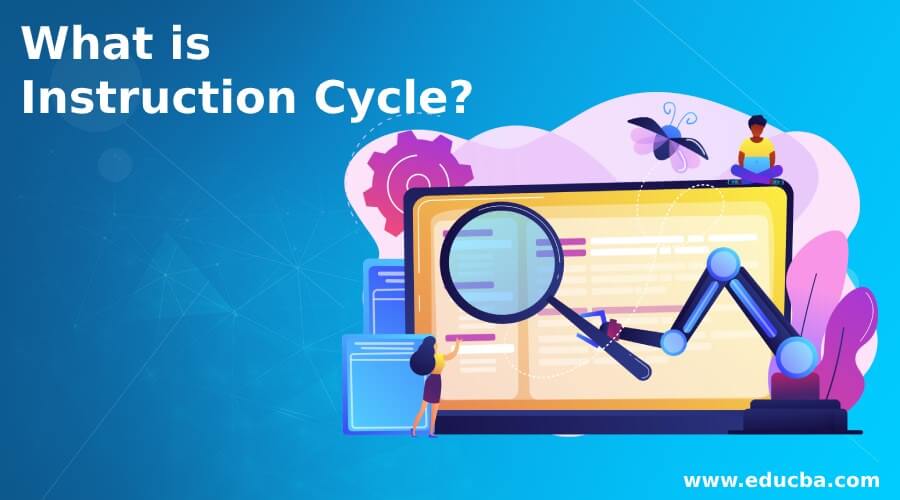Updated May 19, 2023

Introduction to Instruction Cycle
The instruction cycle is related to the CPU (Central processing unit), a list of steps that follows when the computer system starts until the computer system is shut down. The other name of the instruction cycle is the fetch-decode-execute cycle. There are four phases in the instruction cycle: fetching an instruction from memory, decoding the fetched instruction, reading the address from memory, and the last phase include the instruction execution. The computer processor executes it.
What is the Instruction Cycle?
The computer system defines the primary cycle as fetching the instruction from memory, decoding it, and executing it. It is also known as Fetch-Execute-Cycle. The computer system executes all instructions in its RAM. The CPU is responsible for executing the instruction. The CPU system first retrieves the data and instruction from the main memory and then actively stores them in temporary memory, specifically known as registers. During the fetch cycle, the CPU decodes the fetched instructions. This phase is known as the decode phase.
The CPU contains an instructions set that has a predefined list of instructions. In the last phase of the instruction cycle, data processing takes place. In this phase, the CPU executes the instruction and stores the result in another register. After the fetch-decode-execute cycle, the CPU reset itself for another instruction cycle. The CPU system, located in the RAM of the central processing unit, carries out the basic operation cycle and executes the instruction. The CPU continuously repeats this process when the computer system boots up and subsequently shuts down. The execution is sequential, indicating that the next instruction cycle begins only after completing the previous instruction cycle. But in the modern era central processing unit, the instructions can be executed parallelly.
There are five stages of it which are described below:
1. Initiating cycle
In this phase, the computer system boots up, and the operating system loads in the central processing unit’s main memory (read-only memory). It immediately begins when the computer system starts.
2. Fetching of Instruction
The fetching of instructions is the first phase. The fetch instruction is common for each instruction executes in a central processing unit. In this phase, the central processing unit sends the PC to MAR and then sends the READ command into a control bus. The memory sends the instruction stored at the particular address in response to the read command on the data bus. Then, the CPU copies data from the data bus into MBR and then copies the data from MBR to registers. After completing all of this, the pointer increments to the following memory location, enabling the retrieval of the next instruction from memory.
3. Decoding of Instruction
The decoding of instruction is the second phase. In this phase, the CPU determines which instruction is fetched from the instruction and what action needs to be performed on the instruction. The processor fetches the opcode for the instruction from memory and decodes it, determining the related operation that must be performed.
4. Read an Effective Address
The reading of an effective address is the third phase. This phase deals with the decision of the operation. The operation can be of any memory type non-memory type operation. Memory instruction can be categorized into two categories: direct and indirect.
5. Executing of Instruction
The execution of the instruction is the last phase. The instruction is executed in this stage, and the resulting outcome is stored in the register. After the execution of an instruction, the CPU prepares itself for the execution of the next instruction. The calculation of the execution time for each instruction helps determine the processing speed of the processor.
Why do We Need an Instruction Cycle?
- It is necessary for the computer system as it facilitates a proper understanding of the flow of instructions and the execution process within a computer processor.
- The instruction cycle encompasses the entire instructions flow, from booting up the computer system to shutting it down. By providing a clearer understanding of the internal flow of the central processing unit, the instruction cycle actively expedites the resolution of issues.
- It deals with the basic operations of computer processors; there is a need for a proper understanding of the various stages involved.
- The fetch-decode-execute cycle is common for all types of instructions for the computer processor system.
Importance
- Instructions play a crucial role in the processor system as they represent the basic operations performed in the main memory of the central processing unit.
- It is a set of steps that help understand the instruction flow. The instruction cycle in the computer processor allows for the visualization of the end-to-end flow of instructions.
- It is common for all instruction sets it needs to properly understand so that all the operations can be performed easily.
- The instruction cycle enables the calculation of the processing time of a program, which in turn helps determine the processor’s speed.
- The processor’s speed tells how many instructions can be simultaneously executed in the central processing unit.
Conclusion
The instruction cycle is the basic operation cycle related to the computer system, which deals with the basic operation in the central processing unit. The other name of the instruction cycle is fetched decode execute cycle. It continues to repeat until the system reaches the shutdown phase. It is standard for all computer processor systems to have instructions defined.
Recommended Articles
This is a guide to What is Instruction Cycle? Here we discuss the introduction; why do we need an instruction cycle? And importance. You may also have a look at the following articles to learn more –
